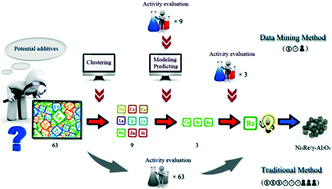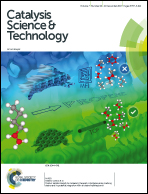Using data mining technology in screening potential additives to Ni/Al2O3 catalysts for methanation†
Abstract
In order to improve the catalytic activity, the screening of optimal potential additives to Ni/Al2O3 catalysts for CO methanation was performed by data mining techniques with a combination of principal component analysis, K-means algorithm and Gaussian process regression (GPR). Based on a tremendous amount of data from previous studies, 63 elements excluding gaseous, poisonous and radioactive ones were selected as initial candidates. After the screening by element clustering, the activities of Ni/Al2O3 catalysts promoted by 9 representative elements including Na, Ca, Cr, B, La, Ru, Cu, Zn, and In were measured, and the catalytic activity was analyzed in terms of T50, which represents the temperature at a CO conversion rate of 50%. The activities and physicochemical properties of the nine elements were used to construct regression models by GPR. The regression models predicted that as a potential additive, Re promotes the activity; we experimentally verified that the T50 dropped by 78 °C relative to that of the unmodified Ni/Al2O3 catalyst. It can be considered to be the most effective one of all additives. The advantages of using data mining techniques in catalyst research are that they reduce the number of catalysts to be empirically analyzed and they accelerate the discovery of new catalysts.



 Please wait while we load your content...
Please wait while we load your content...